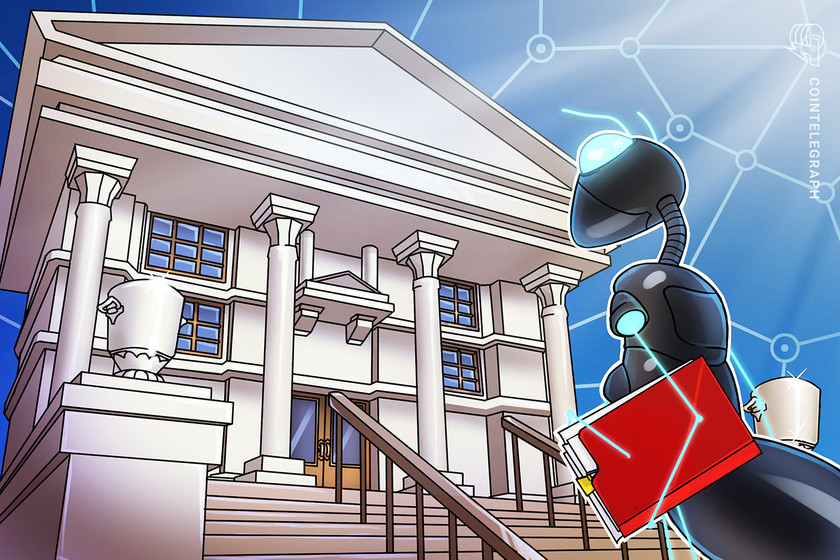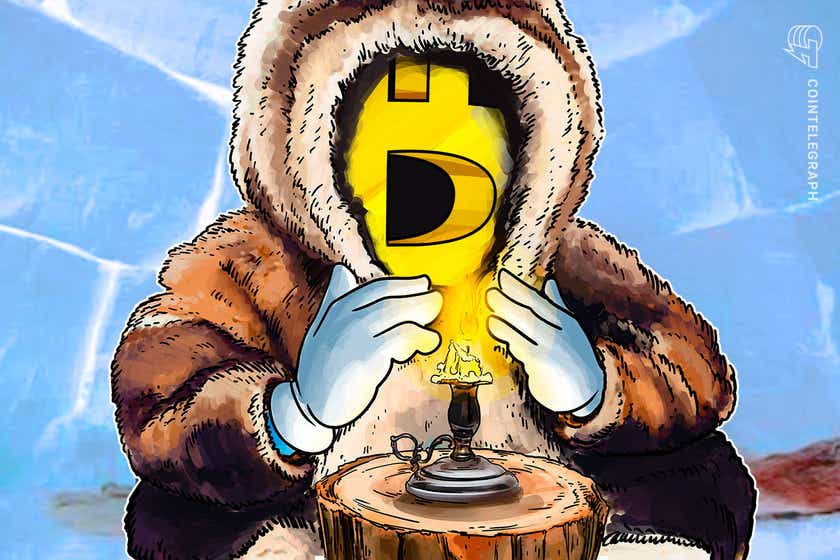From cash to crypto: The Cantillon effect vs. the Nakamoto effect
What is Bitcoin? How does blockchain work? How to mine cryptocurrency? We are glad to help you answer these questions with our quick guides in Explained section.
n”,”seo_description”:”What is Bitcoin? How does blockchain work? How to mine cryptocurrency? We are glad to help you answer these questions with our quick guides in Explained section.”},”words_count”:834,”description”:”Is Bitcoin susceptible to the Cantillon effect? To find an answer, please read this Bitcoin-Cantillon effect article”,”author”:{“id”:1470,”title”:”Onkar Singh”,”url”:”onkar-singh”,”twitter”:””,”google_plus”:””,”photo”:null,”gender”:”male”,”description”:”Onkar Singh is a blockchain enthusiast as he keeps a tab on the recent happenings pertaining to the crypto industry. He aims to provide quality content in blockchain and crypto domain. He is a financial content writer too and has worked on several financial projects related to the stock market news, fundamental research, and technical analysis for several websites.”,”facebook”:””,”email”:””,”linkedin”:””,”created_at”:”2022-01-28 14:30:55″,”updated_at”:”2022-01-28 14:30:55″,”deleted_at”:null,”avatar”:”https://cointelegraph.com/assets/img/icons/author_male.jpg”,”hash”:”aHR0cHM6Ly9jb2ludGVsZWdyYXBoLmNvbS9hdXRob3JzL29ua2FyLXNpbmdo”,”relativeUrl”:”https://cointelegraph.com/authors/onkar-singh”,”user_id”:1470,”language_id”:1,”name”:”Onkar Singh”,”desc”:”Onkar Singh is a blockchain enthusiast as he keeps a tab on the recent happenings pertaining to the crypto industry. He aims to provide quality content in blockchain and crypto domain. He is a financial content writer too and has worked on several financial projects related to the stock market news, fundamental research, and technical analysis for several websites.”,”seo_title”:””,”seo_description”:””,”enabled”:0,”show_in_authors”:0,”show_in_experts”:0},”category_id”:65,”audio”:”https://s3.cointelegraph.com/audio/80295.72c8c8e8-23b2-48d6-b3a2-c8cacfdc9a47.mp3″,”tags”:[{“name”:”Blockchain”,”uri”:”/tags/blockchain”,”super”:1,”page_title”:”Blockchain News”},{“name”:”Satoshi Nakamoto”,”uri”:”/tags/satoshi-nakamoto”,”super”:0,”page_title”:”Satoshi Nakamoto News”}],”tag_title”:”Blockchain”,”date”:”44 MINUTES AGO”,”badge”:{“title”:”Explained”,”label”:”default”},”qty”:27,”stats_pixel”:”“,”stats_pixel_url”:”https://zoa.cointelegraph.com/pixel?postId=80295®ionId=1″,”shares”:5,”infographic”:false,”sponsored”:false,”explained”:true,”press_release”:false,”show_referral”:false,”social_description”:”The Cantillon effect is often cited as one of the causes of cash volatility. Will Bitcoin and the introduction of the Nakamoto effect solve it?”,”social_translators”:{“clipboard_popup_label”:”Link copied”,”socialWechatFooterError”:”WeChat error”,”socialWechatFooterText”:”WeChat share”,”socialWechatHeaderText”:”WeChat share”},”social_shares”:{“post_id”:80295,”post_url”:”https://cointelegraph.com/explained/from-cash-to-crypto-the-cantillon-effect-vs-the-nakamoto-effect”,”post_titles”:{“normal”:”From cash to crypto: The Cantillon effect vs. the Nakamoto effect”,”twitter”:”From cash to crypto: The Cantillon effect vs. the Nakamoto effect”},”post_text”:{“normal”:”From cash to crypto: The Cantillon effect vs. the Nakamoto effect”,”twitter”:”From cash to crypto: The Cantillon effect vs. the Nakamoto effect https://cointelegraph.com/explained/from-cash-to-crypto-the-cantillon-effect-vs-the-nakamoto-effect via @cointelegraph”},”accounts”:{“twitter”:”@cointelegraph”}},”socials”:{“facebook”:{“url”:”https://www.facebook.com/sharer/sharer.php?u=https%3A%2F%2Fcointelegraph.com%2Fexplained%2Ffrom-cash-to-crypto-the-cantillon-effect-vs-the-nakamoto-effect”,”count”:null,”short”:”fb”,”fa”:”facebook”},”twitter”:{“url”:”https://twitter.com/intent/tweet?text=From+cash+to+crypto%3A+The+Cantillon+effect+vs.+the+Nakamoto+effect https%3A%2F%2Fcointelegraph.com%2Fexplained%2Ffrom-cash-to-crypto-the-cantillon-effect-vs-the-nakamoto-effect via @cointelegraph”,”count”:null,”short”:”tw”,”fa”:”twitter”},”telegram”:{“url”:”https://telegram.me/share/url?url=https%3A%2F%2Fcointelegraph.com%2Fexplained%2Ffrom-cash-to-crypto-the-cantillon-effect-vs-the-nakamoto-effect &text=From+cash+to+crypto%3A+The+Cantillon+effect+vs.+the+Nakamoto+effect”,”count”:null,”short”:”tg”,”fa”:”paper-plane”},”whatsapp”:{“url”:”https://api.whatsapp.com/send?text=From+cash+to+crypto%3A+The+Cantillon+effect+vs.+the+Nakamoto+effect&href=https%3A%2F%2Fcointelegraph.com%2Fexplained%2Ffrom-cash-to-crypto-the-cantillon-effect-vs-the-nakamoto-effect”,”count”:null,”short”:”wu”,”fa”:”whatsapp”},”gplus”:{“url”:”https://plus.google.com/share?url=https%3A%2F%2Fcointelegraph.com%2Fexplained%2Ffrom-cash-to-crypto-the-cantillon-effect-vs-the-nakamoto-effect”,”count”:null,”short”:”gplus”,”fa”:”google-plus”},”reddit”:{“url”:”https://www.reddit.com/submit?url=https%3A%2F%2Fcointelegraph.com%2Fexplained%2Ffrom-cash-to-crypto-the-cantillon-effect-vs-the-nakamoto-effect&title=From+cash+to+crypto%3A+The+Cantillon+effect+vs.+the+Nakamoto+effect”,”count”:null,”short”:”reddit”,”fa”:”reddit-alien”},”linkedin”:{“url”:”https://www.linkedin.com/shareArticle?mini=true&url=https%3A%2F%2Fcointelegraph.com%2Fexplained%2Ffrom-cash-to-crypto-the-cantillon-effect-vs-the-nakamoto-effect&title=From+cash+to+crypto%3A+The+Cantillon+effect+vs.+the+Nakamoto+effect”,”count”:null,”short”:”li”,”fa”:”linkedin”}},”hide_disclaimer”:false,”elink”:”https://cointelegraph.com”,”etitle”:”Cointelegraph”,”elogo_x2″:”https://images.cointelegraph.com/images/528_aHR0cHM6Ly9zMy5jb2ludGVsZWdyYXBoLmNvbS9zdG9yYWdlL3VwbG9hZHMvdmlldy9hYjAzYTJhMmNlOWEyMWRjMWYwOTYxZDkxNzMxYzhiYS5wbmc=.png”,”elogo_x1″:”https://images.cointelegraph.com/images/260_aHR0cHM6Ly9zMy5jb2ludGVsZWdyYXBoLmNvbS9zdG9yYWdlL3VwbG9hZHMvdmlldy9hYjAzYTJhMmNlOWEyMWRjMWYwOTYxZDkxNzMxYzhiYS5wbmc=.png”,”elogo_svg”:false,”content”:[{“id”:3161,”post_id”:80295,”title”:”What is the Nakamoto effect?”,”content”:”
Bitcoin introduces the world to the Cantillon effect 2.0, often known as the Nakamoto effect. Those who live closer to the truth can receive value creation benefits in a Bitcoin world, rather than being rewarded for privilege, status or geography.
nn
The issue of why we need Bitcoin (BTC) is a prevalent one these days, but most people’s responses leave them shaking their heads and declaring it to be either a Ponzi scheme or money for criminals. This conclusion falls short of describing how Bitcoin has the potential to address the systemic inequity and corruption that plague our present monetary system.
nn
Miners contributing to the Bitcoin network’s security are rewarded with new Bitcoin and fees based on how much protection they give, referred to as the Nakamoto effect. In contrast, the Cantillon effect, a long-forgotten classical theory on how the distribution of money impacts individual wealth, is one of the injustices in our current society.
nn
Our modern monetary system, which is built on the generation of money primarily through bank-issued debt with interest, transfers wealth from the middle to the top, resulting in an unstable monetary system and a society in which the “future doesn’t matter.”
nn
Between 1970 and 2010, the International Monetary Fund reported 425 systemic banking, monetary and debt crises, an average of 10 each year. Monopolistic state money is a fragile and unequal system, while countries with many currencies have historically experienced greater stability and equality.
nn
The answer to many of these problems regarding state control of money can be found in cryptocurrencies, a new sort of non-state money. After the Great Financial Crisis of 2007–08, the first and most significant of these, Bitcoin, emerged, with the system going online in January 2009.
nn
This article explains the Nakamoto and Cantillon effects, and whether Bitcoin is the antidote to the Cantillon effect.
nn
Please read our guide: Who is Satoshi Nakamoto: The creator of Bitcoin, to understand more about the founder of the world’s first decentralized cryptocurrency.
nnn”,”created_at”:”2022-01-29 13:25:43″,”updated_at”:”2022-01-29 13:28:35″,”sort”:1,”translations”:{“id”:3154,”explained_post_id”:3161,”title_en”:”What is the Nakamoto effect?”,”content_en”:”
Bitcoin introduces the world to the Cantillon effect 2.0, often known as the Nakamoto effect. Those who live closer to the truth can receive value creation benefits in a Bitcoin world, rather than being rewarded for privilege, status or geography.
nn
The issue of why we need Bitcoin (BTC) is a prevalent one these days, but most people’s responses leave them shaking their heads and declaring it to be either a Ponzi scheme or money for criminals. This conclusion falls short of describing how Bitcoin has the potential to address the systemic inequity and corruption that plague our present monetary system.
nn
Miners contributing to the Bitcoin network’s security are rewarded with new Bitcoin and fees based on how much protection they give, referred to as the Nakamoto effect. In contrast, the Cantillon effect, a long-forgotten classical theory on how the distribution of money impacts individual wealth, is one of the injustices in our current society.
nn
Our modern monetary system, which is built on the generation of money primarily through bank-issued debt with interest, transfers wealth from the middle to the top, resulting in an unstable monetary system and a society in which the “future doesn’t matter.”
nn
Between 1970 and 2010, the International Monetary Fund reported 425 systemic banking, monetary and debt crises, an average of 10 each year. Monopolistic state money is a fragile and unequal system, while countries with many currencies have historically experienced greater stability and equality.
nn
The answer to many of these problems regarding state control of money can be found in cryptocurrencies, a new sort of non-state money. After the Great Financial Crisis of 2007–08, the first and most significant of these, Bitcoin, emerged, with the system going online in January 2009.
nn
This article explains the Nakamoto and Cantillon effects, and whether Bitcoin is the antidote to the Cantillon effect.
nn
Please read our guide: Who is Satoshi Nakamoto: The creator of Bitcoin, to understand more about the founder of the world’s first decentralized cryptocurrency.
nnn”,”title_es”:””,”content_es”:”n”,”title_cn”:””,”content_cn”:”n”,”title_de”:””,”content_de”:”n”,”title_it”:””,”content_it”:”n”,”title_ar”:””,”content_ar”:”n”,”title_br”:””,”content_br”:”n”,”title_jp”:””,”content_jp”:”n”,”created_at”:”2022-01-29 13:25:43″,”updated_at”:”2022-01-29 13:28:35″,”title_kr”:””,”content_kr”:”n”,”title_tr”:””,”content_tr”:”n”}},{“id”:3162,”post_id”:80295,”title”:”What are Cantillon effects?”,”content”:”
A change in relative prices resulting from a shift in money supply is known as the Cantillon effect.
nn
Initially defined by 18th-century economist Richard Cantillon, the Cantillon effect is a shift in relative prices caused by a change in the money supply. Making a large amount of cheap money available through banks does not guarantee that the demand for everything will rise simultaneously. Instead, history demonstrates that certain assets outperform others, resulting in price increases in some sections of the economy while prices decline in others.
nn
The Biflation effect is a form of the Cantillon effect. It occurs when the central bank pumps money into the economy to reinflate asset prices during a period of debt deflation (and subsequent recession). Despite the central bank’s efforts, beneficiaries of freshly produced money prefer to spend it on commodities and other associated assets rather than fighting the ongoing deflationary trend in debt markets.
nn
The central bank’s attempt to stimulate the economy may not only fail but instead result in a spike in the cost of living as raw material and consumer basic prices rise, comparable to stagflation’s impacts.
nn
The Cantillon effect is a method of levying an additional tax on anyone who earns a “sticky” wage or has a large portion of their wealth in dollars. This tax rewards people who invest in financial assets or work for the government as preferred contractors. Bitcoin as an investment separates the creation of new money from politics, which makes it far more equitable. But how does the Cantillon effect work?
nn
According to the Cantillon effect, the first recipient of a new money supply has an arbitrage chance to spend money before prices rise. This is partly because new fiat money is created at near-zero cost and distributed to particular parties, most commonly banks. These banks can use this money to buy products and assets whose prices have not yet risen due to the increase in the money supply.
nn
As a result, banks can purchase items at a reduced price. Therefore, individuals and institutions with the closest ties to the central bank — banks and asset owners — are given financial advantages at the expense of those with the fewest links to the financial system. Understanding the Cantillon effect provides that inflation can be viewed as a government-imposed non-legislative and regressive tax on citizens’ purchasing power.
nnn”,”created_at”:”2022-01-29 13:26:17″,”updated_at”:”2022-01-29 13:28:31″,”sort”:2,”translations”:{“id”:3155,”explained_post_id”:3162,”title_en”:”What are Cantillon effects?”,”content_en”:”
A change in relative prices resulting from a shift in money supply is known as the Cantillon effect.
nn
Initially defined by 18th-century economist Richard Cantillon, the Cantillon effect is a shift in relative prices caused by a change in the money supply. Making a large amount of cheap money available through banks does not guarantee that the demand for everything will rise simultaneously. Instead, history demonstrates that certain assets outperform others, resulting in price increases in some sections of the economy while prices decline in others.
nn
The Biflation effect is a form of the Cantillon effect. It occurs when the central bank pumps money into the economy to reinflate asset prices during a period of debt deflation (and subsequent recession). Despite the central bank’s efforts, beneficiaries of freshly produced money prefer to spend it on commodities and other associated assets rather than fighting the ongoing deflationary trend in debt markets.
nn
The central bank’s attempt to stimulate the economy may not only fail but instead result in a spike in the cost of living as raw material and consumer basic prices rise, comparable to stagflation’s impacts.
nn
The Cantillon effect is a method of levying an additional tax on anyone who earns a “sticky” wage or has a large portion of their wealth in dollars. This tax rewards people who invest in financial assets or work for the government as preferred contractors. Bitcoin as an investment separates the creation of new money from politics, which makes it far more equitable. But how does the Cantillon effect work?
nn
According to the Cantillon effect, the first recipient of a new money supply has an arbitrage chance to spend money before prices rise. This is partly because new fiat money is created at near-zero cost and distributed to particular parties, most commonly banks. These banks can use this money to buy products and assets whose prices have not yet risen due to the increase in the money supply.
nn
As a result, banks can purchase items at a reduced price. Therefore, individuals and institutions with the closest ties to the central bank — banks and asset owners — are given financial advantages at the expense of those with the fewest links to the financial system. Understanding the Cantillon effect provides that inflation can be viewed as a government-imposed non-legislative and regressive tax on citizens’ purchasing power.
nnn”,”title_es”:””,”content_es”:”n”,”title_cn”:””,”content_cn”:”n”,”title_de”:””,”content_de”:”n”,”title_it”:””,”content_it”:”n”,”title_ar”:””,”content_ar”:”n”,”title_br”:””,”content_br”:”n”,”title_jp”:””,”content_jp”:”n”,”created_at”:”2022-01-29 13:26:17″,”updated_at”:”2022-01-29 13:28:31″,”title_kr”:””,”content_kr”:”n”,”title_tr”:””,”content_tr”:”n”}},{“id”:3163,”post_id”:80295,”title”:”How does Bitcoin fix the Cantillon effect?”,”content”:”
Unprecedented actions by the central banks and governments of the world’s major economic powers enrich the wealthy while further impoverishing the poor. The famed Cantillon effect lurks underneath this reality, and Bitcoin is the ultimate remedy.
nn
To grasp how Bitcoin alleviates inequity, consider how fiat currencies such as the dollar are allocated now and how fresh Bitcoin is issued.
nn
Almost all of the fiat currency currently issued goes to banks and the government first. This is the case because central banks like the Federal Reserve back big commercial banks like JP Morgan and Citi. Central banks have “printing presses,” that allow them to “print” (or digitally add) a limitless number of their own fiat currency into circulation.
nn
They also impose rules on commercial banks to encourage them to lend more or less money, increasing or decreasing the total money supply. Because banks and the government are the first to get additional money, they determine who is second in line to profit from the Cantillon effect.
nn
This is when lobbying and the influence of being well-connected to the financial elite come into play. Lobbyists ensure that their clients profit from the Cantillon effect, which allows the super-rich and corporations to obtain loans from banks at extremely cheap interest rates.
nn
The Bitcoin system eliminates lobbyist influence and the benefits of knowing the right banker, putting everyone on an equal footing. Every 10 minutes, every miner on the Bitcoin network has an equal chance of winning a reward of newly produced BTC.
nn
Anyone may become a miner by simply connecting a computer into a wall socket, which is significantly less time-consuming than petitioning elected officials for a government contract. Miners spend a lot of money on electricity to fight for the reward, and they provide the Bitcoin system with a much-needed service: security. The Bitcoin system would not work without miners.
nn
Of course, policymakers may influence the Cantillon effect by altering how new money enters the system. However, this does not address the underlying issue: someone benefits at the expense of someone else. The Bitcoin system is significantly more equitable because it employs the Cantillon effect to appropriately reward people who perform a valuable service for everyone else: network security.
nnn”,”created_at”:”2022-01-29 13:26:49″,”updated_at”:”2022-01-29 13:28:31″,”sort”:3,”translations”:{“id”:3156,”explained_post_id”:3163,”title_en”:”How does Bitcoin fix the Cantillon effect?”,”content_en”:”
Unprecedented actions by the central banks and governments of the world’s major economic powers enrich the wealthy while further impoverishing the poor. The famed Cantillon effect lurks underneath this reality, and Bitcoin is the ultimate remedy.
nn
To grasp how Bitcoin alleviates inequity, consider how fiat currencies such as the dollar are allocated now and how fresh Bitcoin is issued.
nn
Almost all of the fiat currency currently issued goes to banks and the government first. This is the case because central banks like the Federal Reserve back big commercial banks like JP Morgan and Citi. Central banks have “printing presses,” that allow them to “print” (or digitally add) a limitless number of their own fiat currency into circulation.
nn
They also impose rules on commercial banks to encourage them to lend more or less money, increasing or decreasing the total money supply. Because banks and the government are the first to get additional money, they determine who is second in line to profit from the Cantillon effect.
nn
This is when lobbying and the influence of being well-connected to the financial elite come into play. Lobbyists ensure that their clients profit from the Cantillon effect, which allows the super-rich and corporations to obtain loans from banks at extremely cheap interest rates.
nn
The Bitcoin system eliminates lobbyist influence and the benefits of knowing the right banker, putting everyone on an equal footing. Every 10 minutes, every miner on the Bitcoin network has an equal chance of winning a reward of newly produced BTC.
nn
Anyone may become a miner by simply connecting a computer into a wall socket, which is significantly less time-consuming than petitioning elected officials for a government contract. Miners spend a lot of money on electricity to fight for the reward, and they provide the Bitcoin system with a much-needed service: security. The Bitcoin system would not work without miners.
nn
Of course, policymakers may influence the Cantillon effect by altering how new money enters the system. However, this does not address the underlying issue: someone benefits at the expense of someone else. The Bitcoin system is significantly more equitable because it employs the Cantillon effect to appropriately reward people who perform a valuable service for everyone else: network security.
nnn”,”title_es”:””,”content_es”:”n”,”title_cn”:””,”content_cn”:”n”,”title_de”:””,”content_de”:”n”,”title_it”:””,”content_it”:”n”,”title_ar”:””,”content_ar”:”n”,”title_br”:””,”content_br”:”n”,”title_jp”:””,”content_jp”:”n”,”created_at”:”2022-01-29 13:26:49″,”updated_at”:”2022-01-29 13:28:31″,”title_kr”:””,”content_kr”:”n”,”title_tr”:””,”content_tr”:”n”}},{“id”:3164,”post_id”:80295,”title”:”How to protect yourself from the Cantillon effect?”,”content”:”
The simplest method to safeguard yourself against the unequal distribution of new money is to leave the monetary system completely.
nn
Only the oldest living generations can recall a time when money was more than a piece of paper backed by the government’s and military’s “full faith and credit.” We are conditioned to conceive of money as a product of our government, yet avoiding the Cantillon effect necessitates looking at money throughout history, even if it is only a century old.
nn
Money used to be defined as gold, a resource that no government can magically produce more of and that needs a great deal of labor to locate and dig out of the ground. Bitcoin is analogous to gold in that no one can suddenly create more of it, and mining it is extremely difficult. On the other hand, Bitcoin travels at the speed of the internet, allowing worldwide commerce in ways that gold cannot.
nn
Protecting yourself from the Cantillon effect necessitates avoiding the unfair fiat currency systems as much as possible by storing wealth in true money, such as gold or BTC. This is the most peaceful method to phase out the old system and replace it with a new, more equitable one.
nnn”,”created_at”:”2022-01-29 13:27:16″,”updated_at”:”2022-01-29 13:28:31″,”sort”:4,”translations”:{“id”:3157,”explained_post_id”:3164,”title_en”:”How to protect yourself from the Cantillon effect?”,”content_en”:”
The simplest method to safeguard yourself against the unequal distribution of new money is to leave the monetary system completely.
nn
Only the oldest living generations can recall a time when money was more than a piece of paper backed by the government’s and military’s “full faith and credit.” We are conditioned to conceive of money as a product of our government, yet avoiding the Cantillon effect necessitates looking at money throughout history, even if it is only a century old.
nn
Money used to be defined as gold, a resource that no government can magically produce more of and that needs a great deal of labor to locate and dig out of the ground. Bitcoin is analogous to gold in that no one can suddenly create more of it, and mining it is extremely difficult. On the other hand, Bitcoin travels at the speed of the internet, allowing worldwide commerce in ways that gold cannot.
nn
Protecting yourself from the Cantillon effect necessitates avoiding the unfair fiat currency systems as much as possible by storing wealth in true money, such as gold or BTC. This is the most peaceful method to phase out the old system and replace it with a new, more equitable one.
nnn”,”title_es”:””,”content_es”:”n”,”title_cn”:””,”content_cn”:”n”,”title_de”:””,”content_de”:”n”,”title_it”:””,”content_it”:”n”,”title_ar”:””,”content_ar”:”n”,”title_br”:””,”content_br”:”n”,”title_jp”:””,”content_jp”:”n”,”created_at”:”2022-01-29 13:27:16″,”updated_at”:”2022-01-29 13:28:31″,”title_kr”:””,”content_kr”:”n”,”title_tr”:””,”content_tr”:”n”}}],”is_partner_material”:false,”commentsSection”:{“schemaEntityUrl”:”//cointelegraph.com/explained/from-cash-to-crypto-the-cantillon-effect-vs-the-nakamoto-effect”,”list”:[],”amount”:0,”i18n”:{“addComment”:”Add a comment…”,”amountOnePostfix”:”Comment”,”amountPostfix”:”Comments”,”cancel”:”Cancel”,”delete”:”Delete”,”edit”:”Edit”,”errorBig”:”Comment text cannot be longer than 2000 characters”,”errorDuplicate”:”Duplicate comment”,”errorSmall”:”Comment text must be at least 2 characters long”,”hideButton”:”Hide comments”,”noComments”:” “,”commentOnModeration”:”Comment on moderation”,”postComment”:”Post”,”reply”:”Reply”,”showAllComments”:”Show All Comments”,”showButtonPostfix”:”comments”,”showButtonPrefix”:”Show”,”signIn”:”Sign in”,”update”:”Update comment”,”commentWasDeleted”:”This comment has been deleted”}},”related”:[{“id”:47052,”retina”:”https://images.cointelegraph.com/images/1480_aHR0cHM6Ly9zMy5jb2ludGVsZWdyYXBoLmNvbS9zdG9yYWdlL3VwbG9hZHMvdmlldy9kNzFiNjNiMWVlZjk4MTA4MTRmYTFhN2MxYzhlMWNlOC5qcGc=.jpg”,”img”:”https://images.cointelegraph.com/images/740_aHR0cHM6Ly9zMy5jb2ludGVsZWdyYXBoLmNvbS9zdG9yYWdlL3VwbG9hZHMvdmlldy9kNzFiNjNiMWVlZjk4MTA4MTRmYTFhN2MxYzhlMWNlOC5qcGc=.jpg”,”thumb”:”https://images.cointelegraph.com/images/370_aHR0cHM6Ly9zMy5jb2ludGVsZWdyYXBoLmNvbS9zdG9yYWdlL3VwbG9hZHMvdmlldy9kNzFiNjNiMWVlZjk4MTA4MTRmYTFhN2MxYzhlMWNlOC5qcGc=.jpg”,”thumb370″:”https://images.cointelegraph.com/images/370_aHR0cHM6Ly9zMy5jb2ludGVsZWdyYXBoLmNvbS9zdG9yYWdlL3VwbG9hZHMvdmlldy9kNzFiNjNiMWVlZjk4MTA4MTRmYTFhN2MxYzhlMWNlOC5qcGc=.jpg”,”amp_thumb”:”https://images.cointelegraph.com/images/150_aHR0cHM6Ly9zMy5jb2ludGVsZWdyYXBoLmNvbS9zdG9yYWdlL3VwbG9hZHMvdmlldy9kNzFiNjNiMWVlZjk4MTA4MTRmYTFhN2MxYzhlMWNlOC5qcGc=.jpg”,”thumb150″:”https://images.cointelegraph.com/images/150_aHR0cHM6Ly9zMy5jb2ludGVsZWdyYXBoLmNvbS9zdG9yYWdlL3VwbG9hZHMvdmlldy9kNzFiNjNiMWVlZjk4MTA4MTRmYTFhN2MxYzhlMWNlOC5qcGc=.jpg”,”url”:”https://cointelegraph.com/news/blockchain-can-disrupt-higher-education-today-global-labor-market-tomorrow”,”title”:”Blockchain Can Disrupt Higher Education Today, Global Labor Market Tomorrow”,”lead”:”Blockchain can play its part in the education sector — record-keeping in 2–3 years and then adoption by the labor market?”,”leadfull”:””,”category_id”:19,”category_url”:”https://cointelegraph.com/category/analysis”,”category_title”:”Analysis”,”author_url”:”https://cointelegraph.com/authors/andrew-singer”,”author_hash”:”aHR0cHM6Ly9jb2ludGVsZWdyYXBoLmNvbS9hdXRob3JzL2FuZHJldy1zaW5nZXI=”,”author_title”:”Andrew Singer”,”author_img”:”https://images.cointelegraph.com/images/32_aHR0cHM6Ly9zMy5jb2ludGVsZWdyYXBoLmNvbS9zdG9yYWdlL3VwbG9hZHMvdmlldy83Mzk1YjJlNjhhNDA5ZGNmMTg2YmJhNzQwNmUzNmY0OS5qcGc=.jpg”,”date”:”JUN 14, 2020″,”flash_date”:”JUN 14, 2020″,”sponsored”:false,”press_release”:false,”sponsored_label”:”Sponsored”,”explained”:false,”badge”:{“title”:”Analysis”,”label”:”info”},”published”:{“date”:”2020-06-14 08:30:00.000000″,”timezone_type”:3,”timezone”:”Europe/London”},”stat_uniqs”:78414,”rss_date”:”Sun, 14 Jun 2020 08:30:00 +0100″,”publishedW3″:”2020-06-14T08:30:00+01:00″,”show_referral”:true,”isMagazine”:false},{“id”:79246,”retina”:”https://images.cointelegraph.com/images/1480_aHR0cHM6Ly9zMy5jb2ludGVsZWdyYXBoLmNvbS9zdG9yYWdlL3VwbG9hZHMvdmlldy82MDNhNzM2NmFhYmVkZDczMGY5MWE1MTUyZmVmNGYyOC5qcGVn.jpeg”,”img”:”https://images.cointelegraph.com/images/740_aHR0cHM6Ly9zMy5jb2ludGVsZWdyYXBoLmNvbS9zdG9yYWdlL3VwbG9hZHMvdmlldy82MDNhNzM2NmFhYmVkZDczMGY5MWE1MTUyZmVmNGYyOC5qcGVn.jpeg”,”thumb”:”https://images.cointelegraph.com/images/370_aHR0cHM6Ly9zMy5jb2ludGVsZWdyYXBoLmNvbS9zdG9yYWdlL3VwbG9hZHMvdmlldy82MDNhNzM2NmFhYmVkZDczMGY5MWE1MTUyZmVmNGYyOC5qcGVn.jpeg”,”thumb370″:”https://images.cointelegraph.com/images/370_aHR0cHM6Ly9zMy5jb2ludGVsZWdyYXBoLmNvbS9zdG9yYWdlL3VwbG9hZHMvdmlldy82MDNhNzM2NmFhYmVkZDczMGY5MWE1MTUyZmVmNGYyOC5qcGVn.jpeg”,”amp_thumb”:”https://images.cointelegraph.com/images/150_aHR0cHM6Ly9zMy5jb2ludGVsZWdyYXBoLmNvbS9zdG9yYWdlL3VwbG9hZHMvdmlldy82MDNhNzM2NmFhYmVkZDczMGY5MWE1MTUyZmVmNGYyOC5qcGVn.jpeg”,”thumb150″:”https://images.cointelegraph.com/images/150_aHR0cHM6Ly9zMy5jb2ludGVsZWdyYXBoLmNvbS9zdG9yYWdlL3VwbG9hZHMvdmlldy82MDNhNzM2NmFhYmVkZDczMGY5MWE1MTUyZmVmNGYyOC5qcGVn.jpeg”,”url”:”https://cointelegraph.com/news/crypto-focused-shopping-site-rolls-out-buy-now-pay-later-feature”,”title”:”Crypto-focused shopping site rolls out ‘buy now, pay later’ feature”,”lead”:”A crypto-focused e-commerce platform now allows shoppers to pay for everyday purchases using digital assets in three interest-free installments.”,”leadfull”:””,”category_id”:62,”category_url”:”https://cointelegraph.com/category/sponsored”,”category_title”:”Sponsored”,”author_url”:”https://cointelegraph.com/authors/edith-m”,”author_hash”:”aHR0cHM6Ly9jb2ludGVsZWdyYXBoLmNvbS9hdXRob3JzL2VkaXRoLW0=”,”author_title”:”Edith M.”,”author_img”:”https://cointelegraph.com/assets/img/icons/author_male.jpg”,”date”:”JAN 12, 2022″,”flash_date”:”JAN 12, 2022″,”sponsored”:true,”press_release”:false,”sponsored_label”:”Sponsored”,”explained”:false,”badge”:{“title”:”Sponsored”,”label”:”default”},”published”:{“date”:”2022-01-12 15:00:00.000000″,”timezone_type”:3,”timezone”:”Europe/London”},”stat_uniqs”:2246,”rss_date”:”Wed, 12 Jan 2022 15:00:00 +0000″,”publishedW3″:”2022-01-12T15:00:00+00:00″,”show_referral”:true,”isMagazine”:false},{“id”:78851,”retina”:”https://images.cointelegraph.com/images/1480_aHR0cHM6Ly9zMy5jb2ludGVsZWdyYXBoLmNvbS91cGxvYWRzLzIwMjItMDEvNTA1NzJmN2UtMTgzNC00YmY3LWFhMzktMDNkNzgzYTYzMDcyLmpwZw==.jpg”,”img”:”https://images.cointelegraph.com/images/740_aHR0cHM6Ly9zMy5jb2ludGVsZWdyYXBoLmNvbS91cGxvYWRzLzIwMjItMDEvNTA1NzJmN2UtMTgzNC00YmY3LWFhMzktMDNkNzgzYTYzMDcyLmpwZw==.jpg”,”thumb”:”https://images.cointelegraph.com/images/370_aHR0cHM6Ly9zMy5jb2ludGVsZWdyYXBoLmNvbS91cGxvYWRzLzIwMjItMDEvNTA1NzJmN2UtMTgzNC00YmY3LWFhMzktMDNkNzgzYTYzMDcyLmpwZw==.jpg”,”thumb370″:”https://images.cointelegraph.com/images/370_aHR0cHM6Ly9zMy5jb2ludGVsZWdyYXBoLmNvbS91cGxvYWRzLzIwMjItMDEvNTA1NzJmN2UtMTgzNC00YmY3LWFhMzktMDNkNzgzYTYzMDcyLmpwZw==.jpg”,”amp_thumb”:”https://images.cointelegraph.com/images/150_aHR0cHM6Ly9zMy5jb2ludGVsZWdyYXBoLmNvbS91cGxvYWRzLzIwMjItMDEvNTA1NzJmN2UtMTgzNC00YmY3LWFhMzktMDNkNzgzYTYzMDcyLmpwZw==.jpg”,”thumb150″:”https://images.cointelegraph.com/images/150_aHR0cHM6Ly9zMy5jb2ludGVsZWdyYXBoLmNvbS91cGxvYWRzLzIwMjItMDEvNTA1NzJmN2UtMTgzNC00YmY3LWFhMzktMDNkNzgzYTYzMDcyLmpwZw==.jpg”,”url”:”https://cointelegraph.com/news/third-largest-whale-celebrates-bitcoin-s-birthday-with-456-btc-buy”,”title”:”Third-largest whale celebrates Bitcoin’s birthday with 456 BTC buy “,”lead”:”After adding 456 BTC, the third-largest whale now holds 120,845.57 BTC, worth over $5.6 billion.”,”leadfull”:””,”category_id”:2,”category_url”:”https://cointelegraph.com/category/latest-news”,”category_title”:”Latest News”,”author_url”:”https://cointelegraph.com/authors/arnold-kirimi”,”author_hash”:”aHR0cHM6Ly9jb2ludGVsZWdyYXBoLmNvbS9hdXRob3JzL2Fybm9sZC1raXJpbWk=”,”author_title”:”Arnold Kirimi”,”author_img”:”https://images.cointelegraph.com/images/32_aHR0cHM6Ly9zMy5jb2ludGVsZWdyYXBoLmNvbS9zdG9yYWdlL3VwbG9hZHMvdmlldy8wNWMyODg3ZTczYWZlMmE0NDhkNzg2N2NjMjk5MDg5My5qcGc=.jpg”,”date”:”JAN 04, 2022″,”flash_date”:”JAN 04, 2022″,”sponsored”:false,”press_release”:false,”sponsored_label”:”Sponsored”,”explained”:false,”badge”:{“title”:”News”,”label”:”default”},”published”:{“date”:”2022-01-04 10:46:19.000000″,”timezone_type”:3,”timezone”:”Europe/London”},”stat_uniqs”:9585,”rss_date”:”Tue, 04 Jan 2022 10:46:19 +0000″,”publishedW3″:”2022-01-04T10:46:19+00:00″,”show_referral”:true,”isMagazine”:false},{“id”:80280,”retina”:”https://images.cointelegraph.com/images/1480_aHR0cHM6Ly9zMy5jb2ludGVsZWdyYXBoLmNvbS91cGxvYWRzLzIwMjItMDEvMDM0MTllMDktODA3Ny00MTAyLWIyMmItMWE5ZjA0MGRlYzNhLmpwZw==.jpg”,”img”:”https://images.cointelegraph.com/images/740_aHR0cHM6Ly9zMy5jb2ludGVsZWdyYXBoLmNvbS91cGxvYWRzLzIwMjItMDEvMDM0MTllMDktODA3Ny00MTAyLWIyMmItMWE5ZjA0MGRlYzNhLmpwZw==.jpg”,”thumb”:”https://images.cointelegraph.com/images/370_aHR0cHM6Ly9zMy5jb2ludGVsZWdyYXBoLmNvbS91cGxvYWRzLzIwMjItMDEvMDM0MTllMDktODA3Ny00MTAyLWIyMmItMWE5ZjA0MGRlYzNhLmpwZw==.jpg”,”thumb370″:”https://images.cointelegraph.com/images/370_aHR0cHM6Ly9zMy5jb2ludGVsZWdyYXBoLmNvbS91cGxvYWRzLzIwMjItMDEvMDM0MTllMDktODA3Ny00MTAyLWIyMmItMWE5ZjA0MGRlYzNhLmpwZw==.jpg”,”amp_thumb”:”https://images.cointelegraph.com/images/150_aHR0cHM6Ly9zMy5jb2ludGVsZWdyYXBoLmNvbS91cGxvYWRzLzIwMjItMDEvMDM0MTllMDktODA3Ny00MTAyLWIyMmItMWE5ZjA0MGRlYzNhLmpwZw==.jpg”,”thumb150″:”https://images.cointelegraph.com/images/150_aHR0cHM6Ly9zMy5jb2ludGVsZWdyYXBoLmNvbS91cGxvYWRzLzIwMjItMDEvMDM0MTllMDktODA3Ny00MTAyLWIyMmItMWE5ZjA0MGRlYzNhLmpwZw==.jpg”,”url”:”https://cointelegraph.com/news/fitch-says-proposed-russia-crypto-ban-eases-risks-but-curbs-innovation”,”title”:”Fitch says proposed Russia crypto ban eases risks but curbs innovation”,”lead”:”Russia’s retail cryptocurrency operations currently stand at about $5 billion per year. “,”leadfull”:””,”category_id”:2,”category_url”:”https://cointelegraph.com/category/latest-news”,”category_title”:”Latest News”,”author_url”:”https://cointelegraph.com/authors/zhiyuan-sun”,”author_hash”:”aHR0cHM6Ly9jb2ludGVsZWdyYXBoLmNvbS9hdXRob3JzL3poaXl1YW4tc3Vu”,”author_title”:”Zhiyuan Sun”,”author_img”:”https://images.cointelegraph.com/images/32_aHR0cHM6Ly9zMy5jb2ludGVsZWdyYXBoLmNvbS9zdG9yYWdlL3VwbG9hZHMvdmlldy82ZTIyODkzYzk0NDBjMGYxMTk1MDU3YzE4ZGFiMDBhYS5qcGc=.jpg”,”date”:”JAN 28, 2022″,”flash_date”:”JAN 28, 2022″,”sponsored”:false,”press_release”:false,”sponsored_label”:”Sponsored”,”explained”:false,”badge”:{“title”:”News”,”label”:”default”},”published”:{“date”:”2022-01-28 21:45:00.000000″,”timezone_type”:3,”timezone”:”Europe/London”},”stat_uniqs”:1025,”rss_date”:”Fri, 28 Jan 2022 21:45:00 +0000″,”publishedW3″:”2022-01-28T21:45:00+00:00″,”show_referral”:true,”isMagazine”:false},{“id”:80281,”retina”:”https://images.cointelegraph.com/images/1480_aHR0cHM6Ly9zMy5jb2ludGVsZWdyYXBoLmNvbS91cGxvYWRzLzIwMjItMDEvOWNlZjc3NzMtNjhhYS00MmUxLTk1MTYtYmIxNTAwOTQyMjcwLmpwZw==.jpg”,”img”:”https://images.cointelegraph.com/images/740_aHR0cHM6Ly9zMy5jb2ludGVsZWdyYXBoLmNvbS91cGxvYWRzLzIwMjItMDEvOWNlZjc3NzMtNjhhYS00MmUxLTk1MTYtYmIxNTAwOTQyMjcwLmpwZw==.jpg”,”thumb”:”https://images.cointelegraph.com/images/370_aHR0cHM6Ly9zMy5jb2ludGVsZWdyYXBoLmNvbS91cGxvYWRzLzIwMjItMDEvOWNlZjc3NzMtNjhhYS00MmUxLTk1MTYtYmIxNTAwOTQyMjcwLmpwZw==.jpg”,”thumb370″:”https://images.cointelegraph.com/images/370_aHR0cHM6Ly9zMy5jb2ludGVsZWdyYXBoLmNvbS91cGxvYWRzLzIwMjItMDEvOWNlZjc3NzMtNjhhYS00MmUxLTk1MTYtYmIxNTAwOTQyMjcwLmpwZw==.jpg”,”amp_thumb”:”https://images.cointelegraph.com/images/150_aHR0cHM6Ly9zMy5jb2ludGVsZWdyYXBoLmNvbS91cGxvYWRzLzIwMjItMDEvOWNlZjc3NzMtNjhhYS00MmUxLTk1MTYtYmIxNTAwOTQyMjcwLmpwZw==.jpg”,”thumb150″:”https://images.cointelegraph.com/images/150_aHR0cHM6Ly9zMy5jb2ludGVsZWdyYXBoLmNvbS91cGxvYWRzLzIwMjItMDEvOWNlZjc3NzMtNjhhYS00MmUxLTk1MTYtYmIxNTAwOTQyMjcwLmpwZw==.jpg”,”url”:”https://cointelegraph.com/news/certik-s-identification-of-crypto-cars-as-rug-pull-was-a-false-alarm”,”title”:”CertiK’s identification of Crypto Cars as ‘rug pull’ was a false alarm “,”lead”:”A temporary website outage of the project’s main site, among other factors, led to the error.”,”leadfull”:””,”category_id”:2,”category_url”:”https://cointelegraph.com/category/latest-news”,”category_title”:”Latest News”,”author_url”:”https://cointelegraph.com/authors/zhiyuan-sun”,”author_hash”:”aHR0cHM6Ly9jb2ludGVsZWdyYXBoLmNvbS9hdXRob3JzL3poaXl1YW4tc3Vu”,”author_title”:”Zhiyuan Sun”,”author_img”:”https://images.cointelegraph.com/images/32_aHR0cHM6Ly9zMy5jb2ludGVsZWdyYXBoLmNvbS9zdG9yYWdlL3VwbG9hZHMvdmlldy82ZTIyODkzYzk0NDBjMGYxMTk1MDU3YzE4ZGFiMDBhYS5qcGc=.jpg”,”date”:”JAN 28, 2022″,”flash_date”:”JAN 28, 2022″,”sponsored”:false,”press_release”:false,”sponsored_label”:”Sponsored”,”explained”:false,”badge”:{“title”:”News”,”label”:”default”},”published”:{“date”:”2022-01-28 22:00:00.000000″,”timezone_type”:3,”timezone”:”Europe/London”},”stat_uniqs”:7784,”rss_date”:”Fri, 28 Jan 2022 22:00:00 +0000″,”publishedW3″:”2022-01-28T22:00:00+00:00″,”show_referral”:true,”isMagazine”:false},{“id”:80285,”retina”:”https://images.cointelegraph.com/images/1480_aHR0cHM6Ly9zMy5jb2ludGVsZWdyYXBoLmNvbS91cGxvYWRzLzIwMjItMDEvMWQyODM5YjItOTA5Yy00ZDk1LWEzOGEtN2I4N2U5ZTY1ZGExLmpwZw==.jpg”,”img”:”https://images.cointelegraph.com/images/740_aHR0cHM6Ly9zMy5jb2ludGVsZWdyYXBoLmNvbS91cGxvYWRzLzIwMjItMDEvMWQyODM5YjItOTA5Yy00ZDk1LWEzOGEtN2I4N2U5ZTY1ZGExLmpwZw==.jpg”,”thumb”:”https://images.cointelegraph.com/images/370_aHR0cHM6Ly9zMy5jb2ludGVsZWdyYXBoLmNvbS91cGxvYWRzLzIwMjItMDEvMWQyODM5YjItOTA5Yy00ZDk1LWEzOGEtN2I4N2U5ZTY1ZGExLmpwZw==.jpg”,”thumb370″:”https://images.cointelegraph.com/images/370_aHR0cHM6Ly9zMy5jb2ludGVsZWdyYXBoLmNvbS91cGxvYWRzLzIwMjItMDEvMWQyODM5YjItOTA5Yy00ZDk1LWEzOGEtN2I4N2U5ZTY1ZGExLmpwZw==.jpg”,”amp_thumb”:”https://images.cointelegraph.com/images/150_aHR0cHM6Ly9zMy5jb2ludGVsZWdyYXBoLmNvbS91cGxvYWRzLzIwMjItMDEvMWQyODM5YjItOTA5Yy00ZDk1LWEzOGEtN2I4N2U5ZTY1ZGExLmpwZw==.jpg”,”thumb150″:”https://images.cointelegraph.com/images/150_aHR0cHM6Ly9zMy5jb2ludGVsZWdyYXBoLmNvbS91cGxvYWRzLzIwMjItMDEvMWQyODM5YjItOTA5Yy00ZDk1LWEzOGEtN2I4N2U5ZTY1ZGExLmpwZw==.jpg”,”url”:”https://cointelegraph.com/news/sec-approves-bstx-for-blockchain-settlements-on-traditional-markets”,”title”:”SEC approves BSTX for blockchain settlements on traditional markets”,”lead”:”BSTX‘s SEC approval does not involve crypto trading or any other form of use of blockchain technology. “,”leadfull”:””,”category_id”:2,”category_url”:”https://cointelegraph.com/category/latest-news”,”category_title”:”Latest News”,”author_url”:”https://cointelegraph.com/authors/arijit-sarkar”,”author_hash”:”aHR0cHM6Ly9jb2ludGVsZWdyYXBoLmNvbS9hdXRob3JzL2FyaWppdC1zYXJrYXI=”,”author_title”:”Arijit Sarkar”,”author_img”:”https://images.cointelegraph.com/images/32_aHR0cHM6Ly9zMy5jb2ludGVsZWdyYXBoLmNvbS9zdG9yYWdlL3VwbG9hZHMvdmlldy8zNDRiYzQ0MWU3OWQyMDE3NTdlOTZmZWQxMTEyYjQxMi5qcGc=.jpg”,”date”:”17 HOURS AGO”,”flash_date”:”JAN 29, 2022″,”sponsored”:false,”press_release”:false,”sponsored_label”:”Sponsored”,”explained”:false,”badge”:{“title”:”News”,”label”:”default”},”published”:{“date”:”2022-01-29 05:31:57.000000″,”timezone_type”:3,”timezone”:”Europe/London”},”stat_uniqs”:5598,”rss_date”:”Sat, 29 Jan 2022 05:31:57 +0000″,”publishedW3″:”2022-01-29T05:31:57+00:00″,”show_referral”:true,”isMagazine”:false}]}” :shares=”{“facebook”:{“url”:”https://www.facebook.com/sharer/sharer.php?u=%URL%”,”icon”:”facebook”,”title”:”Facebook”,”sizesAllowed”:[{“size”:”lg”,”label”:”Large devices”,”breakpoint”:”> 1200px”},{“size”:”md”,”label”:”Medium devices”,”breakpoint”:”> 992px”},{“size”:”sm”,”label”:”Small tablets”,”breakpoint”:”> 768px”},{“size”:”xs”,”label”:”Smartphones”,”breakpoint”:”> 480px”},{“size”:”xxs”,”label”:”Extra small devices”,”breakpoint”:”< 480px"}],"position":1,"status":true},"twitter":{"url":"https://twitter.com/intent/tweet?text=%TEXT%","icon":"twitter","title":"Twitter","position":2,"status":true,"sizesAllowed":[{"size":"xxs","label":"Extra small devices","breakpoint":"< 480px"},{"size":"xs","label":"Smartphones","breakpoint":"> 480px”},{“size”:”sm”,”label”:”Small tablets”,”breakpoint”:”> 768px”},{“size”:”md”,”label”:”Medium devices”,”breakpoint”:”> 992px”},{“size”:”lg”,”label”:”Large devices”,”breakpoint”:”> 1200px”}]},”telegram”:{“url”:”https://t.me/share/url?url=%URL%&text=%TEXT%”,”icon”:”telegram”,”title”:”Telegram”,”position”:3,”status”:true,”sizesAllowed”:[{“size”:”xxs”,”label”:”Extra small devices”,”breakpoint”:”< 480px"},{"size":"xs","label":"Smartphones","breakpoint":"> 480px”},{“size”:”sm”,”label”:”Small tablets”,”breakpoint”:”> 768px”},{“size”:”md”,”label”:”Medium devices”,”breakpoint”:”> 992px”},{“size”:”lg”,”label”:”Large devices”,”breakpoint”:”> 1200px”}]},”linkedin”:{“url”:”https://www.linkedin.com/shareArticle?mini=true&url=%URL%&title=%TITLE%”,”icon”:”linked-in”,”title”:”LinkedIn”,”position”:5,”status”:true,”sizesAllowed”:[{“size”:”xxs”,”label”:”Extra small devices”,”breakpoint”:”< 480px"},{"size":"xs","label":"Smartphones","breakpoint":"> 480px”},{“size”:”sm”,”label”:”Small tablets”,”breakpoint”:”> 768px”},{“size”:”md”,”label”:”Medium devices”,”breakpoint”:”> 992px”},{“size”:”lg”,”label”:”Large devices”,”breakpoint”:”> 1200px”}]},”copy”:{“url”:”%URL%”,”icon”:”copy”,”position”:7,”title”:”Copy Link”,”sizesAllowed”:[{“size”:”xxs”,”label”:”Extra small devices”,”breakpoint”:”< 480px"},{"size":"xs","label":"Smartphones","breakpoint":"> 480px”},{“size”:”sm”,”label”:”Small tablets”,”breakpoint”:”> 768px”},{“size”:”md”,”label”:”Medium devices”,”breakpoint”:”> 992px”},{“size”:”lg”,”label”:”Large devices”,”breakpoint”:”> 1200px”}],”status”:true},”whatsapp”:{“url”:”https://wa.me/?text=%TITLE% %URL%”,”icon”:”whats-app”,”title”:”Whatsapp”,”sizesAllowed”:[{“size”:”xxs”,”label”:”Extra small devices”,”breakpoint”:”< 480px"},{"size":"xs","label":"Smartphones","breakpoint":"> 480px”},{“size”:”sm”,”label”:”Small tablets”,”breakpoint”:”> 768px”},{“size”:”md”,”label”:”Medium devices”,”breakpoint”:”> 992px”},{“size”:”lg”,”label”:”Large devices”,”breakpoint”:”> 1200px”}],”position”:6,”status”:true},”reddit”:{“url”:”https://www.reddit.com/submit?url=%URL%&title=%TITLE%”,”icon”:”reddit”,”title”:”Reddit”,”sizesAllowed”:[{“size”:”xxs”,”label”:”Extra small devices”,”breakpoint”:”< 480px"},{"size":"xs","label":"Smartphones","breakpoint":"> 480px”},{“size”:”sm”,”label”:”Small tablets”,”breakpoint”:”> 768px”},{“size”:”md”,”label”:”Medium devices”,”breakpoint”:”> 992px”},{“size”:”lg”,”label”:”Large devices”,”breakpoint”:”> 1200px”}],”position”:4,”status”:true}}” is=”ExplainedPostPage”>
Bitcoin introduces the world to the Cantillon effect 2.0, often known as the Nakamoto effect. Those who live closer to the truth can receive value creation benefits in a Bitcoin world, rather than being rewarded for privilege, status or geography.
The issue of why we need Bitcoin (BTC) is a prevalent one these days, but most people’s responses leave them shaking their heads and declaring it to be either a Ponzi scheme or money for criminals. This conclusion falls short of describing how Bitcoin has the potential to address the systemic inequity and corruption that plague our present monetary system.
Miners contributing to the Bitcoin network’s security are rewarded with new Bitcoin and fees based on how much protection they give, referred to as the Nakamoto effect. In contrast, the Cantillon effect, a long-forgotten classical theory on how the distribution of money impacts individual wealth, is one of the injustices in our current society.
Our modern monetary system, which is built on the generation of money primarily through bank-issued debt with interest, transfers wealth from the middle to the top, resulting in an unstable monetary system and a society in which the “future doesn’t matter.”
Between 1970 and 2010, the International Monetary Fund reported 425 systemic banking, monetary and debt crises, an average of 10 each year. Monopolistic state money is a fragile and unequal system, while countries with many currencies have historically experienced greater stability and equality.
The answer to many of these problems regarding state control of money can be found in cryptocurrencies, a new sort of non-state money. After the Great Financial Crisis of 2007–08, the first and most significant of these, Bitcoin, emerged, with the system going online in January 2009.
This article explains the Nakamoto and Cantillon effects, and whether Bitcoin is the antidote to the Cantillon effect.
Please read our guide: Who is Satoshi Nakamoto: The creator of Bitcoin, to understand more about the founder of the world’s first decentralized cryptocurrency.
A change in relative prices resulting from a shift in money supply is known as the Cantillon effect.
Initially defined by 18th-century economist Richard Cantillon, the Cantillon effect is a shift in relative prices caused by a change in the money supply. Making a large amount of cheap money available through banks does not guarantee that the demand for everything will rise simultaneously. Instead, history demonstrates that certain assets outperform others, resulting in price increases in some sections of the economy while prices decline in others.
The Biflation effect is a form of the Cantillon effect. It occurs when the central bank pumps money into the economy to reinflate asset prices during a period of debt deflation (and subsequent recession). Despite the central bank’s efforts, beneficiaries of freshly produced money prefer to spend it on commodities and other associated assets rather than fighting the ongoing deflationary trend in debt markets.
The central bank’s attempt to stimulate the economy may not only fail but instead result in a spike in the cost of living as raw material and consumer basic prices rise, comparable to stagflation’s impacts.
The Cantillon effect is a method of levying an additional tax on anyone who earns a “sticky” wage or has a large portion of their wealth in dollars. This tax rewards people who invest in financial assets or work for the government as preferred contractors. Bitcoin as an investment separates the creation of new money from politics, which makes it far more equitable. But how does the Cantillon effect work?
According to the Cantillon effect, the first recipient of a new money supply has an arbitrage chance to spend money before prices rise. This is partly because new fiat money is created at near-zero cost and distributed to particular parties, most commonly banks. These banks can use this money to buy products and assets whose prices have not yet risen due to the increase in the money supply.
As a result, banks can purchase items at a reduced price. Therefore, individuals and institutions with the closest ties to the central bank — banks and asset owners — are given financial advantages at the expense of those with the fewest links to the financial system. Understanding the Cantillon effect provides that inflation can be viewed as a government-imposed non-legislative and regressive tax on citizens’ purchasing power.
Unprecedented actions by the central banks and governments of the world’s major economic powers enrich the wealthy while further impoverishing the poor. The famed Cantillon effect lurks underneath this reality, and Bitcoin is the ultimate remedy.
To grasp how Bitcoin alleviates inequity, consider how fiat currencies such as the dollar are allocated now and how fresh Bitcoin is issued.
Almost all of the fiat currency currently issued goes to banks and the government first. This is the case because central banks like the Federal Reserve back big commercial banks like JP Morgan and Citi. Central banks have “printing presses,” that allow them to “print” (or digitally add) a limitless number of their own fiat currency into circulation.
They also impose rules on commercial banks to encourage them to lend more or less money, increasing or decreasing the total money supply. Because banks and the government are the first to get additional money, they determine who is second in line to profit from the Cantillon effect.
This is when lobbying and the influence of being well-connected to the financial elite come into play. Lobbyists ensure that their clients profit from the Cantillon effect, which allows the super-rich and corporations to obtain loans from banks at extremely cheap interest rates.
The Bitcoin system eliminates lobbyist influence and the benefits of knowing the right banker, putting everyone on an equal footing. Every 10 minutes, every miner on the Bitcoin network has an equal chance of winning a reward of newly produced BTC.
Anyone may become a miner by simply connecting a computer into a wall socket, which is significantly less time-consuming than petitioning elected officials for a government contract. Miners spend a lot of money on electricity to fight for the reward, and they provide the Bitcoin system with a much-needed service: security. The Bitcoin system would not work without miners.
Of course, policymakers may influence the Cantillon effect by altering how new money enters the system. However, this does not address the underlying issue: someone benefits at the expense of someone else. The Bitcoin system is significantly more equitable because it employs the Cantillon effect to appropriately reward people who perform a valuable service for everyone else: network security.
The simplest method to safeguard yourself against the unequal distribution of new money is to leave the monetary system completely.
Only the oldest living generations can recall a time when money was more than a piece of paper backed by the government’s and military’s “full faith and credit.” We are conditioned to conceive of money as a product of our government, yet avoiding the Cantillon effect necessitates looking at money throughout history, even if it is only a century old.
Money used to be defined as gold, a resource that no government can magically produce more of and that needs a great deal of labor to locate and dig out of the ground. Bitcoin is analogous to gold in that no one can suddenly create more of it, and mining it is extremely difficult. On the other hand, Bitcoin travels at the speed of the internet, allowing worldwide commerce in ways that gold cannot.
Protecting yourself from the Cantillon effect necessitates avoiding the unfair fiat currency systems as much as possible by storing wealth in true money, such as gold or BTC. This is the most peaceful method to phase out the old system and replace it with a new, more equitable one.









